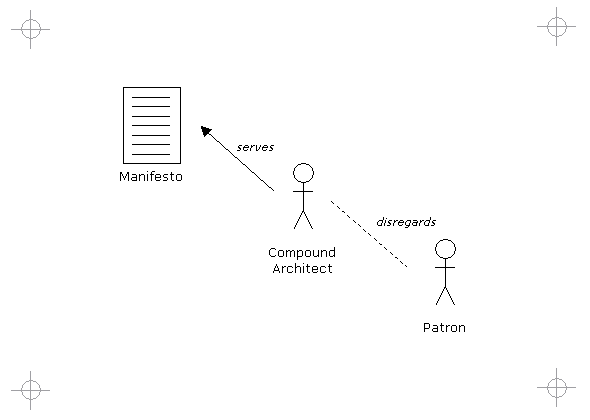|
Diagram
|
|
|

|
|
Title
|
|
|
Compound Architects
|
|
Building Architecture
|
|
|
Tom Wolfe coined the phrase "Compound Architects" as a reference to the modernist architects (such as those at the Bauhaus) who in his view lived in closed communal compounds and put their manifestos or ideals over and above the needs of their patrons or clients.
|
|
Architecture Intensive Disciplines
|
|
|
Architecture must serve the needs of the customer. Architecture for architecture's sake is a luxury in today's profit driven world. Methodologies, documentation, visual models and artifact gathering are not an end in themselves. But what constitutes "compound architects" today are not those architects pursuing quality and value for the business but those who seek to sell vendor specific platforms or products as an architecture. An architecture does not create itself, nor does it come from purchasing products or a technology platform. "Compound Architects" are those who believe that one solution fixes all problems. They are often selling a product rather than providing a service.
|
|
Case Study A: Large Corporate IT
|
|
|

|
|
|
Admittedly, this is a failing of many architects and this case is no exception. In my job interview, I was asked to implement the repository based architecture I had developed. My suggestion was to pilot it on a small application and try and focus on delivering a project success. The development manager and I agreed not to discuss the architecture but to focus on delivery.
What turned out to be a small term contract and a small application - became core to one of the key business units. The integrity of the architecture became paramount and put a lot of emphasis on it in latter stages. In hindsight perhaps we had unnecessarily placed the architecture above the business patron or customer.
|
|
Case Study B: Small Commercial Team
|
|
|

|
|
|
In this case study, there was a more determined goal not to lose sight of the customer and business needs. Unfortunately, the system was brittle - it was difficult to make changes without impacting other parts of the system. We may have been criticised for undertaking a major refactoring of the software but it was possibly the only way we could learn it and begin to take ownership and accountability for changes.
|
|
|


